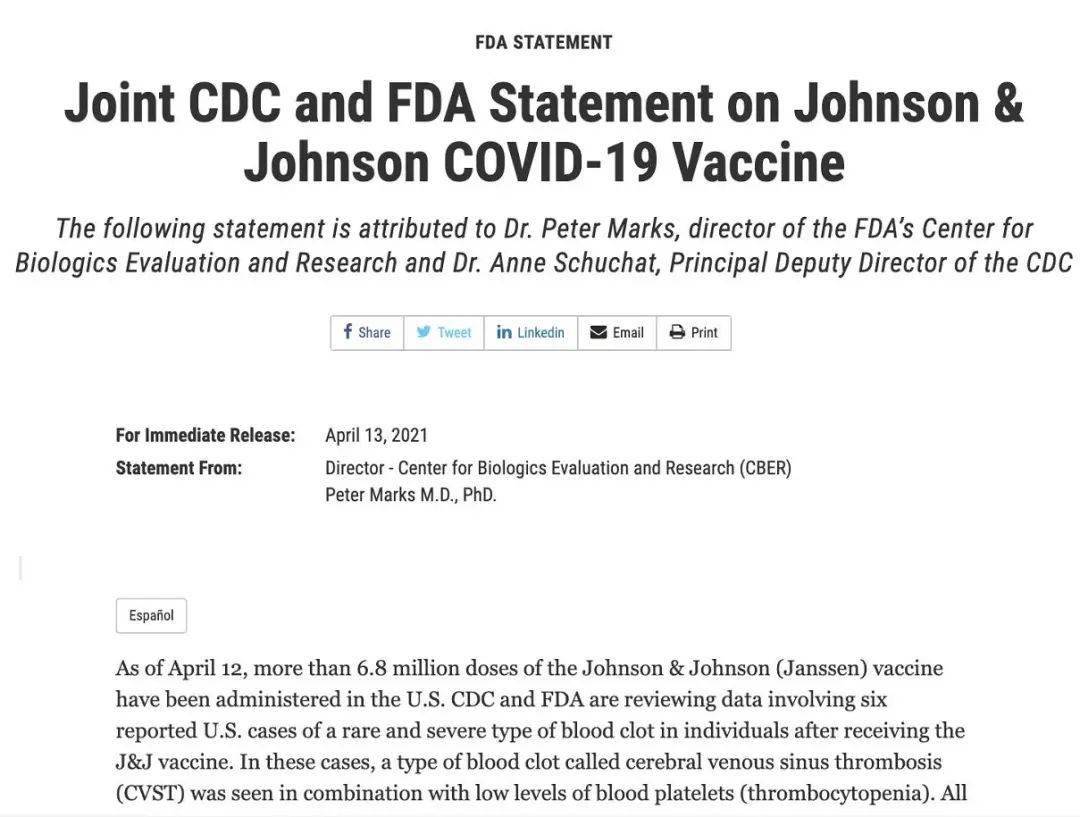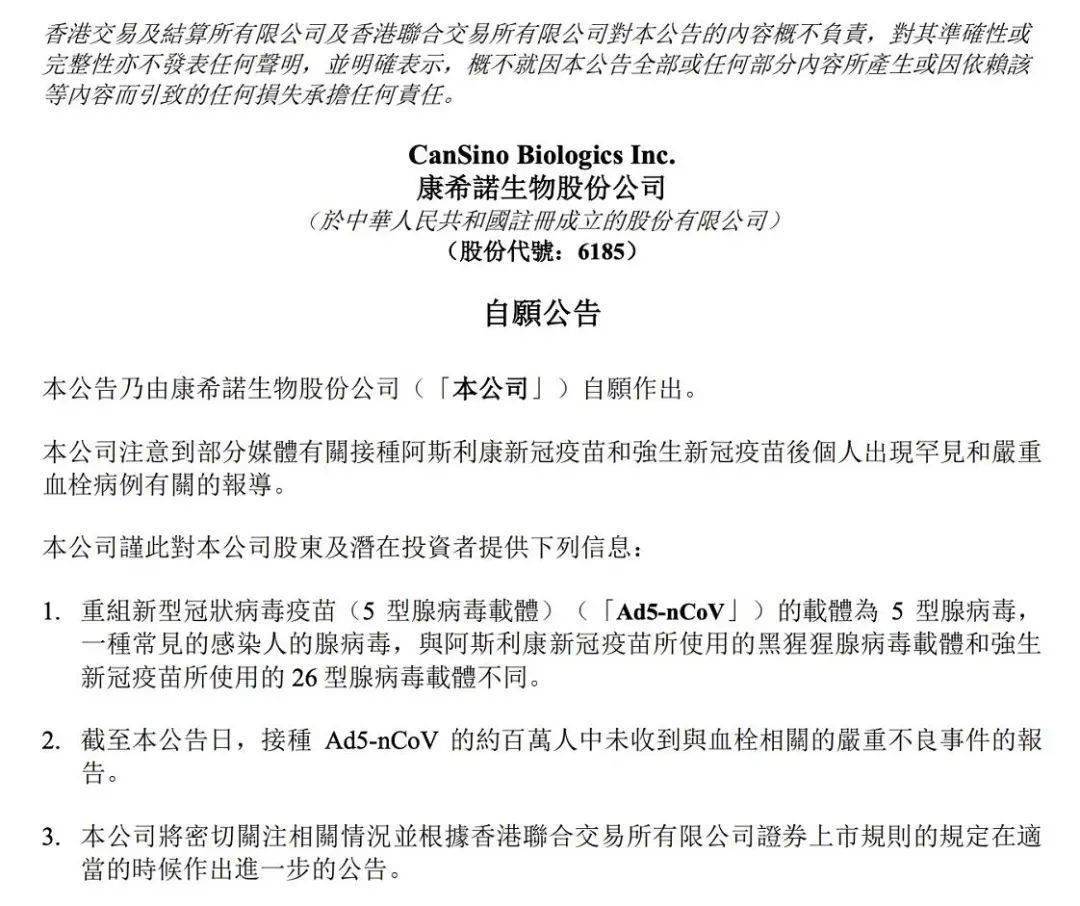China Times reporter Cui Xiaotian reports from Beijing

The overseas new crown vaccine “thrombus gate” continued to ferment. Following AstraZeneca, Johnson & Johnson’s vaccine was also urgently stopped.
On April 13, the U.S. Centers for Disease Control and Prevention (CDC) and the U.S. Food and Drug Administration (FDA) issued a joint statement stating that in view of the fact that the U.S. has reported 6 cases of “rare and severe” thrombosis after being vaccinated by Johnson & Johnson, It is recommended to suspend vaccination of Johnson & Johnson’s new crown vaccine.

In this regard, vaccine expert Tao Lina (Vaccines and Science) told the reporter of China Times that even if it is finally confirmed that the vaccines of AstraZeneca and Johnson & Johnson have caused rare blood clots, it is necessary to weigh the pros and cons before making a decision.
As the vaccines of AstraZeneca and Johnson & Johnson are both adenovirus vector vaccines, CanSino shares continue to fall sharply. From April 14th to 15th at noon, Cansino A shares reported 349.16 yuan per share, a cumulative decline of about 8% during this period; Hong Kong stocks reported 270.8 Hong Kong dollars per share, a cumulative decline of about 14% during the period.
Johnson & Johnson Vaccines Was Urgently Stopped by the U.S.
According to the official website of the FDA, Johnson & Johnson’s vaccine was approved for emergency use on February 27 for use by people over 18 years of age. It was developed by Johnson & Johnson’s Janssen Pharmaceuticals. This vaccine is an adenovirus vector vaccine. It only requires one dose. The most common side effects are pain at the injection site, headache, fatigue, muscle aches and nausea. Most of these side effects occur within 1-2 days after vaccination, and are mild to moderate and last for 1-2 days.
The above 6 cases of adverse reactions occurred during the vaccination process of more than 6.8 million doses of Johnson & Johnson vaccine, all women aged 18-48, who developed cerebral venous sinus thrombosis and thrombocytopenia at the same time 6 to 13 days after vaccination. This side effect is “extremely rare” and the treatment is different from common blood clots.
On April 14, the CDC’s Immunization Practice Advisory Committee met to discuss these cases, and the FDA has also begun investigating these cases. At present, it has not been confirmed that there is a clear causal relationship between rare thrombotic events and Johnson & Johnson’s new crown vaccine. The two agencies recommended that states suspend continued vaccination against Johnson & Johnson until the complete investigation process is over.
In response, Johnson & Johnson issued a statement on the 13th, saying: “We have been reviewing these cases with European drug regulatory agencies. We have decided to proactively postpone the promotion of the vaccine in Europe, and suspend all clinical trials of the new crown vaccine, and update the research. The guidance of the participants and the participants.”
Anthony Fauci, director of the National Institute of Allergy and Infectious Diseases, said that the suspension of the Johnson & Johnson vaccine is out of cautious consideration, allowing relevant institutions to further understand the status of patients with adverse reactions and the mechanism of side effects. The probability of such side effects is extremely low, so those who have been vaccinated by Johnson & Johnson need not be anxious.
The health department recommends that people who experience severe headache, abdominal pain, leg pain, or shortness of breath within three weeks after receiving the Johnson & Johnson new crown vaccine should contact their healthcare provider.
At present, the suspension of Johnson & Johnson vaccination will not have a major impact on the progress of the new crown vaccination in the United States. Jeff Zienz, an expert on the US White House’s New Crown Epidemic Response Team, said that Johnson & Johnson vaccines account for less than 5% of the current US vaccination records. The US government is working with states and partners to help the Johnson & Johnson vaccines that have been booked. The patient should be rescheduled to receive Pfizer or Modena vaccine as soon as possible.
In fact, four days before the United States stopped Johnson & Johnson’s vaccination, the European Union has begun to review the safety of the vaccine. The vaccine was approved for conditional marketing in the EU in March, but has not yet been delivered. According to the plan, Johnson & Johnson will provide at least 200 million doses of the new crown vaccine to the EU within this year.
Following AstraZeneca’s footsteps?
It seems that Johnson & Johnson has followed in the footsteps of another multinational giant, AstraZeneca.
In March, due to the symptoms of bleeding, thrombosis and reduced platelet counts among medical staff in Denmark, Norway and other places after vaccination, nearly 20 countries including Germany, France, Denmark, Norway, Iceland, Italy, Thailand, Austria, etc. once called for a stop. Sleek vaccination.
On April 7, expert teams from the European Medicines Agency (EMA) and the World Health Organization (WTO) successively issued statements stating that the vaccine developed by AstraZeneca and the University of Oxford may be related to rare blood clots. The EMA Safety Committee (PRAC) believes that rare thrombosis with thrombocytopenia should be classified as a very rare side effect of the AstraZeneca vaccine. However, the overall benefits of the vaccine in preventing new coronary pneumonia outweigh the risk of side effects.
PRAC conducted an in-depth review of the 62 cases of cerebral venous sinus thrombosis and 24 cases of splenic vein thrombosis reported in the EU drug safety database as of March 22, 2021. Among them, 18 cases were fatal. These cases were mainly from the spontaneous reporting system of the EU and the United Kingdom. Approximately 25 million people have received the vaccine.
PRAC pointed out that thrombosis occurs in cerebral veins (cerebral venous sinus thrombosis) and abdominal veins (splenic vein thrombosis) and arteries, accompanied by low platelet levels and sometimes bleeding. So far, most of the reported cases have occurred in women under 60 years of age within 2 weeks of vaccination.
AstraZeneca said that it will update the vaccine product instructions and add information about the vaccine and “very rare” thrombosis on the new label. Together with the WTO and EMA, we are conducting unified observations on patients with symptoms after vaccination and conducting further research.
At present, many countries have announced adjustments to the AstraZeneca vaccination groups, including the United Kingdom, the Philippines, Australia, South Korea, Belgium, etc., but there are differences in age. The United Kingdom advises against vaccinating AstraZeneca for people under 30 years of age, Belgium suspends vaccinations for people 55 years of age and under, Australia suspends vaccinations for people under 50 years of age, and Spain, South Korea and the Philippines only for people over 60 years of age Get the vaccine.
Recently, the “New England Journal of Medicine” published two important studies at the same time, analyzing the symptoms of thrombosis and thrombocytopenia in patients after vaccination with AstraZeneca.
In the first study, the Norwegian research team reported that 5 cases of rare venous thrombosis and thrombocytopenia were found in more than 130,000 vaccinators. High levels of antibodies against PF4-polyanion complex were detected in the blood of all patients. This antibody can activate platelets, leading to abnormal formation of thrombus and a decrease in the number of free platelets.
In the second study, the German research team analyzed the clinical and blood test data of 11 patients who experienced thrombosis or thrombocytopenia after being vaccinated with AstraZeneca in Germany and Austria. Testing of patients’ blood samples also found high levels of antibody responses to PF4-heparin complex or PF4. Historical studies have shown that other factors besides heparin may also trigger symptoms very similar to heparin-induced thrombocytopenia.
China’s Cansino vaccine implicated
It is worth noting that the vaccines of Johnson & Johnson and AstraZeneca both follow the path of adenovirus vector technology. Now that one after another is involved in the “thrombus gate”, are other adenovirus vector vaccines still safe?
At present, in addition to Johnson & Johnson and AstraZeneca, the satellite 5 (Sputnik-V) developed by Russia, and the new crown vaccine developed by China’s Cansino Biotechnology Co., Ltd. also belong to the adenovirus vector technology path. However, according to public information, the adenovirus vectors used in these four vaccines are different. The AstraZeneca vaccine uses the chimpanzee adenovirus vector, the Johnson & Johnson vaccine is based on the Ad26 adenovirus vector, and the Cansino vaccine uses the Ad5 adenovirus as the carrier. The first dose of the Russian satellite 5 vaccine uses Ad26 as the carrier, and the second dose uses Ad5 as the carrier. Carrier.
Affected by this news, Cansino’s stock price plummeted, A shares fell by 13%, and H shares fell by 18%. CanSino Bio had to issue an emergency statement stating that the Ad5 vector used by the company’s new crown vaccine is a common adenovirus that infects humans, which is different from the adenovirus vector used by AstraZeneca and Johnson & Johnson vaccines. As of the 14th, about one million people vaccinated with Cansino vaccine have not received reports of serious adverse events related to thrombosis. After the company’s statement was issued, the decline in Cansino’s share price narrowed. As of the close, Cansino A shares closed at 356.20 yuan per share, the decline narrowed to 6%; the decline of Hong Kong stocks also narrowed to 8%.

CITIC Securities believes that this phenomenon has not been found among the millions of vaccinators of Cansino vaccine; this has not been found in the previous use of Ad5 in other vaccines and drugs; after all, Ad5 is a viral vector with a high infection rate in humans. It is different from AstraZeneca, Johnson & Johnson and Carrier, and the probability of thrombosis is very different.
So, is Ad5 adenovirus vector safer? Taolina said that there are some studies on the thrombocytopenia caused by adenoviral vectors, but these studies are based on the results of high-dose systemic therapeutic applications.
In September 2011, Yu Xiunan and other researchers from the First Affiliated Hospital of Harbin Medical University published an article “Research Progress in Adenovirus Type 5 and Thrombocytopenia” in the Journal of Modern Laboratory Medicine, which mentioned that thrombocytopenia Symptoms are a major side effect of high-dose systemic application of adenovirus as a vector for gene therapy of carriers. Adenovirus can bind to CAR receptors on platelets, and can also bind to integrin receptors on platelets. “Recent studies have found that adenovirus may cause activated platelets. Adenovirus-induced thrombocytopenia is considered to be dose-dependent, saturated and reversible, which is consistent with the ligand-receptor mechanism. There are multiple views on the mechanism.”
Regarding the Johnson & Johnson vaccine, “I’m still suspending the use and continuing to evaluate it, but compared to no vaccination, I am expressly willing to accept the adenovirus vector vaccine.” Taolina said.





























































You must log in to post a comment.